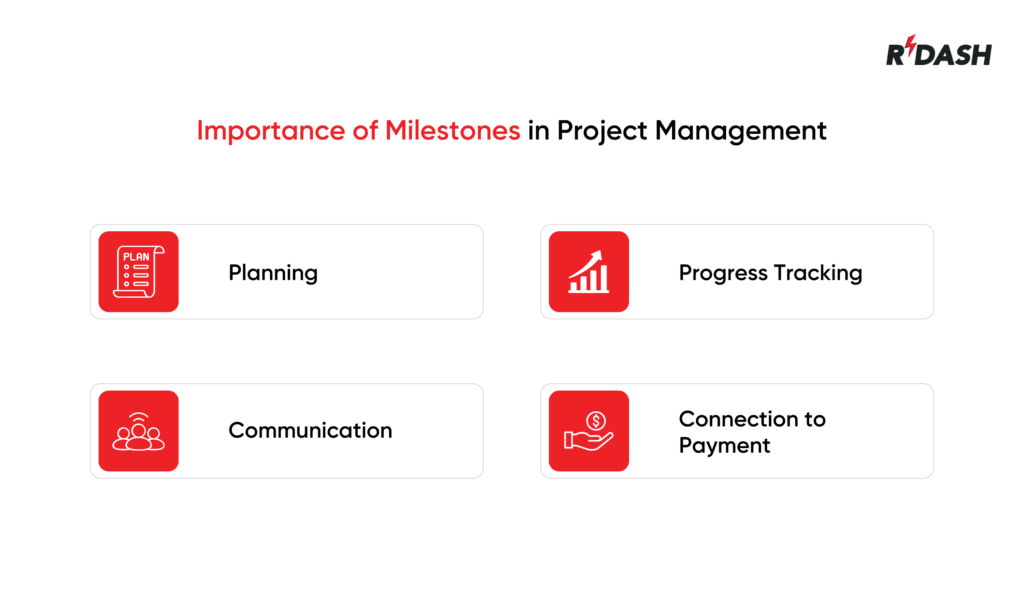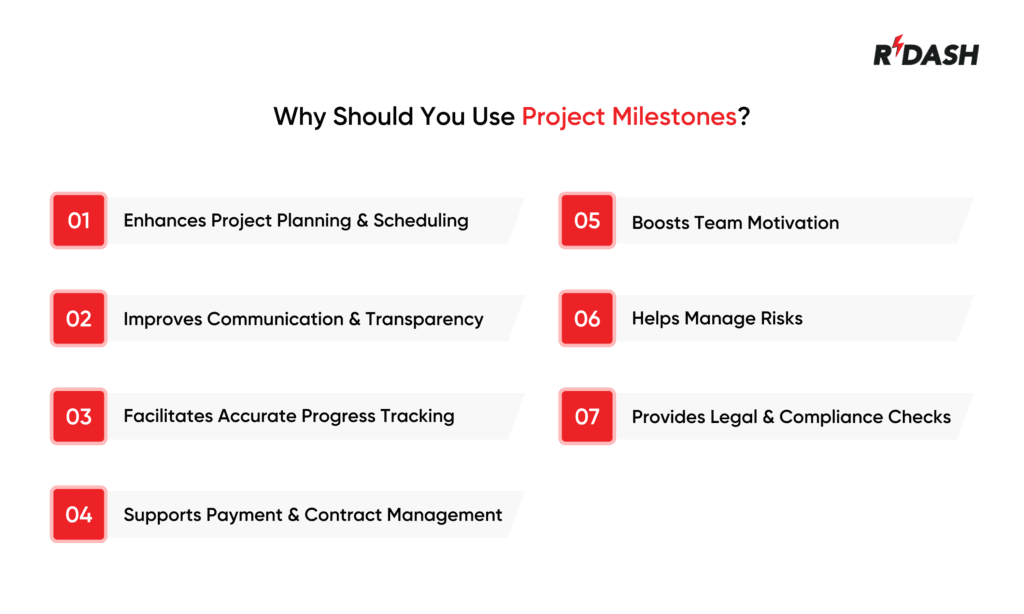What is a construction project management milestone?
In construction project management, a milestone is a significant event or point in the timeline that marks the completion of a major phase or important task. Milestones help the project team understand progress without focusing on every small activity. They are like checkpoints that guide the project from start to finish.
Importance of milestones in project management
Milestones play a key role in managing construction projects well. Their importance can be seen in the following areas:

Planning
Milestones help in organizing the entire project by breaking it down into smaller, manageable parts. When milestones are set, project managers can plan activities and schedules around these key points. This makes it easier to assign resources and prepare for the next steps. Without milestones, it would be difficult to keep track of complex projects.
Communication
Milestones provide a clear way to communicate progress to everyone involved, including clients, contractors, and workers. Instead of reporting every detail, project teams can simply say which milestones have been completed. This improves transparency and keeps all parties informed about the project’s status.
Progress Tracking
Milestones act as indicators to measure how the project is moving forward. Project managers regularly check if milestones are met on time. Meeting milestones shows the project is on schedule, while delays indicate problems that need attention. This helps in taking timely actions to avoid bigger delays.
Connection to Payment
Many construction contracts link payments to the achievement of milestones. This means that when a milestone is completed, it triggers a payment to the contractor. This method ensures clients pay for completed work, making payment schedules clear and fair. It also motivates contractors to meet deadlines and maintain quality.
Tools for efficiently managing project goals
In modern construction management, tracking project milestones is a vital feature, and RDash integrates this seamlessly into its planning tools.
With RDash, project managers can create detailed activity schedules that break down the project into clear phases and tasks. The Gantt chart feature then translates this schedule into an easy-to-understand visual timeline, displaying task durations, dependencies, and important milestone points.
These visual aids help teams spot overlapping tasks, identify any extra buffer time, and flag activities that could cause delays. Additionally, sharing these charts with clients and stakeholders fosters transparency, ensuring everyone stays up-to-date on project progress and key achievements.
Consequences of missing project milestones
Missing project milestones in construction can have serious effects on the entire project. When a milestone is not completed on time, it creates delays that may push back other activities. This can lead to increased costs because more resources or overtime might be needed to catch up. Delays can also damage the reputation of the contractor and cause dissatisfaction among clients.
Furthermore, missing milestones affects project tracking. It becomes harder to measure progress accurately, which can lead to poor decision-making. When payments are linked to milestones, delays may also cause payment hold-ups, affecting cash flow for contractors. Overall, missing milestones can disrupt the entire workflow and cause a chain reaction of problems that slow down project completion.
Common project milestones used in construction
In the construction industry, milestones are essential markers that help track progress and ensure projects stay on schedule. These milestones represent significant achievements or completion points within a project and serve as important checkpoints for all stakeholders. Below are some common project milestones typically used in construction projects:
1. Site Preparation Completed
This milestone signifies that the construction site is fully cleared, leveled, and ready for the beginning of actual construction work. It includes activities like demolition, excavation, grading, and removal of any obstacles.
2. Foundation Work Finished
Completion of the foundation marks the end of groundwork and the start of vertical construction. This includes laying concrete, setting footings, and waterproofing, which are crucial for the structural integrity of the building.
3. Structural Frame Erected
This milestone indicates that the main skeleton or frame of the building has been assembled. Whether it’s steel, concrete, or timber framing, this stage shows visible progress and defines the building’s shape.
4. Roofing Installed
Once the roof is in place, the structure is protected from weather elements, allowing interior work to proceed safely. This milestone usually includes installing trusses, roof covering, and insulation.
5. Mechanical, Electrical, and Plumbing (MEP) Rough-Ins Completed
This involves installing the basic infrastructure for electrical wiring, plumbing pipes, HVAC ducts, and fire protection systems. Completing these installations is critical before walls and ceilings are closed.
6. Exterior Walls and Windows Installed
With the building enclosed by exterior walls and windows, this milestone signals that the structure is weather-tight, allowing for interior finishes to begin.
7. Interior Finishes Completed
This phase includes painting, flooring, cabinetry, fixtures, and other finishing touches. It marks the near-completion of the building and prepares the space for occupancy.
8. Final Inspections Passed
After all construction work is done, passing inspections from local authorities is essential to ensure compliance with building codes and safety regulations. Achieving this milestone allows for legal occupancy.
9. Project Handover and Closeout
The final milestone is the official handover of the completed building to the client. This stage involves delivering documentation, warranties, and training the client on building systems.
These milestones provide a roadmap that helps everyone involved understand where the project stands and what needs to be accomplished next.
Why should you use project milestones?
Using project milestones in construction brings many advantages that improve the overall success of the project. Here’s why integrating milestones into your project plan is important:

1. Enhances Project Planning and Scheduling
Milestones break down large projects into smaller, manageable parts, making it easier to create a realistic timeline. They help project managers allocate resources effectively and schedule tasks logically, ensuring a smoother workflow.
2. Improves Communication and Transparency
Project milestones act as clear communication points for sharing updates with clients, contractors, and team members. Instead of overwhelming stakeholders with daily task details, milestones provide straightforward progress reports that everyone can understand.
3. Facilitates Accurate Progress Tracking
By regularly reviewing if milestones have been met, project managers can monitor whether the project is on schedule. If a milestone is missed, it raises an early warning, allowing the team to address issues before they cause bigger delays.
4. Supports Payment and Contract Management
Many construction contracts link payments to the completion of specific milestones. This approach ensures that contractors are paid only for work completed, protecting clients from premature payments and motivating contractors to meet deadlines.
5. Boosts Team Motivation and Focus
Visible progress markers help motivate the project team by showing clear achievements. Reaching milestones creates a sense of accomplishment and keeps the team focused on the next goals.
6. Helps Manage Risks and Avoid Cost Overruns
Early identification of delays or problems through missed milestones enables timely corrective actions. This proactive approach reduces the risk of budget overruns and helps keep the project within scope.
7. Provides Legal and Regulatory Compliance Checks
Certain milestones, such as passing inspections or obtaining permits, ensure the project complies with local laws and regulations. Integrating these into the project schedule prevents legal complications later.
8. Aids in Client Satisfaction and Trust
Regular milestone updates keep clients informed and involved throughout the project. This transparency builds trust, helps manage expectations, and often leads to better client relationships.






